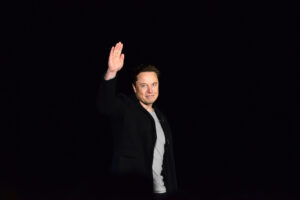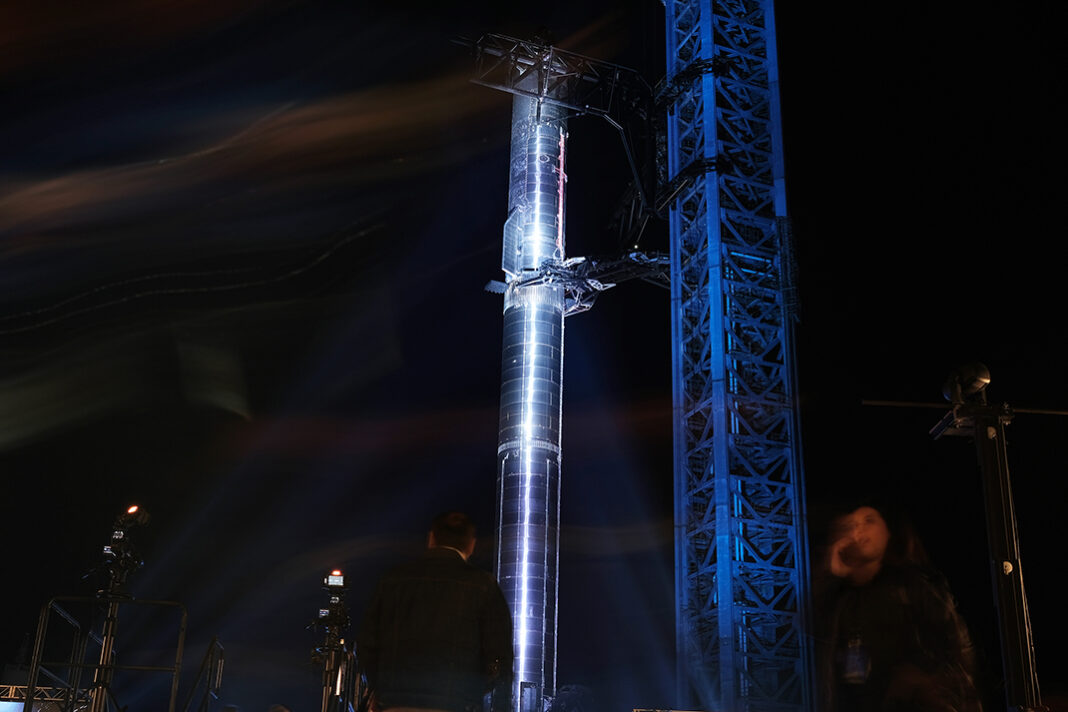
SpaceX founder and CEO Elon Musk, presenting his Feb. 10 update on Starship development live from the company’s Boca Chica site, dubbed Starbase, said the historic first orbital test launch of a Starship-Super Heavy vehicle could be from Florida’s Cape Canaveral rather than Cameron County, depending on the results of a Federal Aviation Administration environmental review expected to be released soon.
The FAA is wrapping up a Final Programmatic Environmental Assessment (PEA) of SpaceX’s plans for Boca Chica, begun after the company moved the bulk of its Starship development program here as opposed to the original plan of 12 commercial launches a year using much less powerful Falcon rockets as opposed to the Super Heavy boosters now being built at Boca Chica.
Starship is being developed as the Human Landing System for NASA’s Artemis program to put astronauts on the moon for the first time in half a century, to carry people to Mars to establish self-sustaining settlements as a means of ensuring the survival of the human race, and to eventually take humans out of the solar system altogether. Starship is also being developed for transporting people and cargo between points on Earth.
If the FAA renders a “Finding of No Significant Impact” it would likely issue a launch license to SpaceX for the orbital launch from Boca Chica. If the agency determines a full Environmental Impact Statement is warranted, no orbital launch from Cameron County will take place until completion of the more exhaustive EIS, and perhaps not even then depending on the outcome.
Musk delivered his presentation to a packed crowd of spectators and journalists against a dramatic backdrop of the illuminated orbital Starship prototype SN20 stacked atop Super Heavy BN4, both secured by huge robotic arms attached to the site’s equally impressive, 400-foot-tall launch/catch tower.
The FAA originally had planned to release the results of the Final PEA Dec. 31, but said it needed more time to process the more than 18,000 public comments generated in response to the Draft PEA released in September.
“We don’t have a ton of insight into where things stand with the FAA,” Musk said. “We’ve gotten sort of a rough indication that there may be an approval in March, but that’s all we know.”
He said he’s optimistic the FAA will grant approval, adding that “objectively, I think is not something that will be harmful to the environment.” Despite earlier failures to land a Starship prototype successfully, which in one case resulted in Starship pieces being scattered over a large area, those hurdles were surmounted on last May 5 when the three-engine Starship SN15 executed an incident-free launch, high-altitude flight and landing at Boca Chica.
Musk said he thinks SpaceX’s team has enough experience successfully launching Starships now that the first launch of the Starship/Super Heavy combination “would not have a significant impact.” He conceded that litigation could also delay the first orbital launch from Boca Chica, if not a thumbs-down from the FAA. But Musk has a backup plan.
“Now we do have the alternative of the Cape,” he said. “We actually applied for environmental approval for launching from the Cape a few years ago and received it. So we are actually approved from an environmental standpoint to launch from (launch pad) 39A. I guess our worst-case scenario is that we would be delayed for six to eight months to build up the Cape launch tower and launch from there.”
An EIS for Boca Chica would take much longer than the EA, which the FAA started last summer, “so we’d have to shift our priorities to Cape (Canaveral),” Musk said.
Assuming orbital Starship development is allowed to continue at Boca Chica, though, the site is well suited as SpaceX’s advanced research-and-development location, he said.
“So it’s like where we would try out new designs and new versions of the rocket,” Musk said. “And then I think probably Cape (Canaveral) would be our sort of main operational launch site. And then over time I think there’s going to be floating spaceports like ocean spaceports. We’ve got these two converted oil rigs that are going to be turned into orbital launch sites, and they can be moved around the world. I think there could be quite a few of those.
“I think about … what would really work for long distance. Because the rocket is quite loud you want to be, I don’t know, 20 miles away from a major city, or 30 miles away from a major city just so you’re not disturbing people too much. I think most of the launch sites long term will be kind of ocean- or sea-based ports.”
Musk said he thinks people would tolerate an occasional noisy launch, but not on a regular basis. The converted rigs, christened Deimos and Phobos after the two moons of Saturn, have been a low priority to date as SpaceX has concentrated on creating a functional launch site at Boca Chica, he said. But the company plans to build at least a “catch tower” — and at some point full launch capability — on one of the offshore platforms later this year, Musk said.
“Hopefully by the end of this year we will have a launch capability at Cape (Canaveral) at 39A and at one of the ocean platforms as well,” he said.
The idea is for the launch/catch tower’s robotic pincers to grab the first-stage Super Heavy as it lands, about six minutes after separating from the orbital Starship after launch, Musk said. That’s part of SpaceX’s goal of being able to quickly reuse Starships and Super Heavys, which is the key to making all of it work, he said.
“We need to accomplish that,” Musk said. “It’s not done yet. Success is one of the possible outcomes. We’re aiming for rapid reusability, which is why the booster is going to take off and then fly back to the launch tower and, aspirationally, land on the arms, which does sound insane. … If it does come in too fast and shear off the arms, then I guess it will be a farewell to arms. The bad jokes, I just have to warn you, they’re only going to get worse.”
“Farewell to Arms” is a 1929 novel by Ernest Hemingway.
Musk said he’s proud of the SpaceX team for everything they’ve been able to achieve and thanked officials with the city of Brownsville, South Padre Island and Cameron County for their support, as well as the FAA and NASA for choosing SpaceX to put astronauts on the moon again.
Musk began the night’s presentation with an explanation of why he’s doing what he’s doing: Building giant rockets with the ultimate goal of making humans an interplanetary species. One reason is “life insurance,” he said, noting that “the dinosaurs are not around anymore.”
“There could be some calamity where we do ourselves in, or there’s just a natural disaster,” Musk said. “Now I’m naturally an optimist, so I think the probability of that is low, but it is not zero.”
At any rate, the sun “in a few hundred million years” will expand and kill everything on Earth, he noted. Becoming interplanetary means not just helping ensure the survival of the human species, but of other species as well, Musk said.
“We are life’s stewards, life’s guardians,” he said. “The creatures that we love can’t build spaceships, but we can, and we can bring them with us. And I think that’s pretty important for those that care about the environment and care about all the creatures on Earth.”
The other reason for pushing the envelope of what’s possible with spaceflight, Musk said, is about being inspired and “excited about the future.” Becoming a space-faring civilization means a chance to solve some of the ageless riddles of life and the universe, or “find what the heck’s going on,” he said.
“If we go out there, we explore the galaxy, ultimately, maybe we could find out some of these questions,” Musk said. “It would just be very exciting to do that and something for people to look forward to.
“Vicariously we can all go there, just like with Apollo, where only a handful of people went to the moon, but in a sense we all went there. Humanity went there. So even if somebody doesn’t choose to go themselves I think vicariously through others they will go. They will understand. They will experience the universe. And I think that’s incredibly fundamental to an exciting future. That’s why we’re doing this.”




